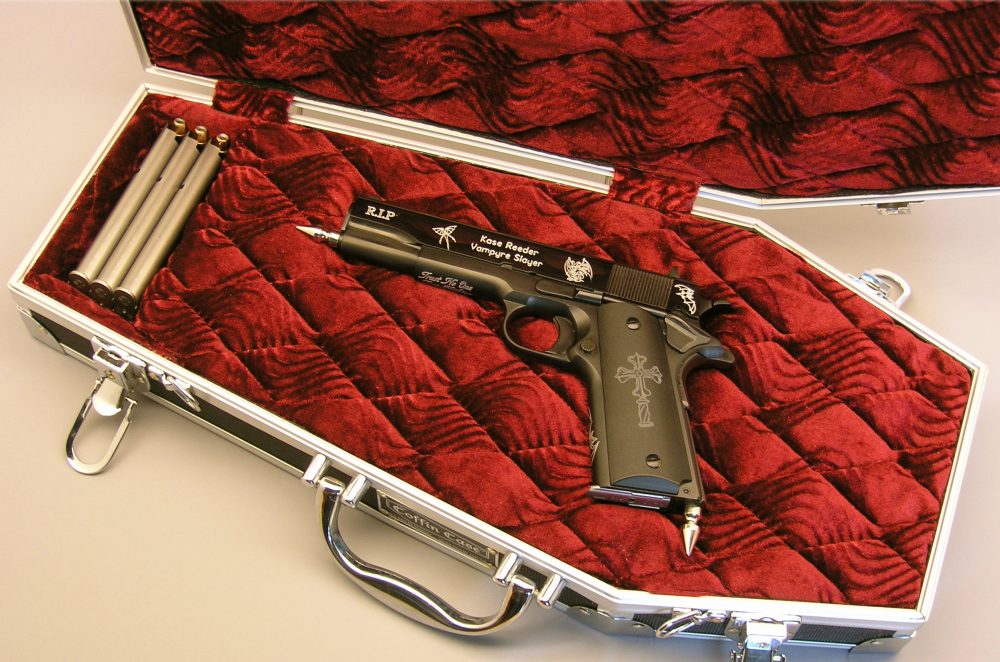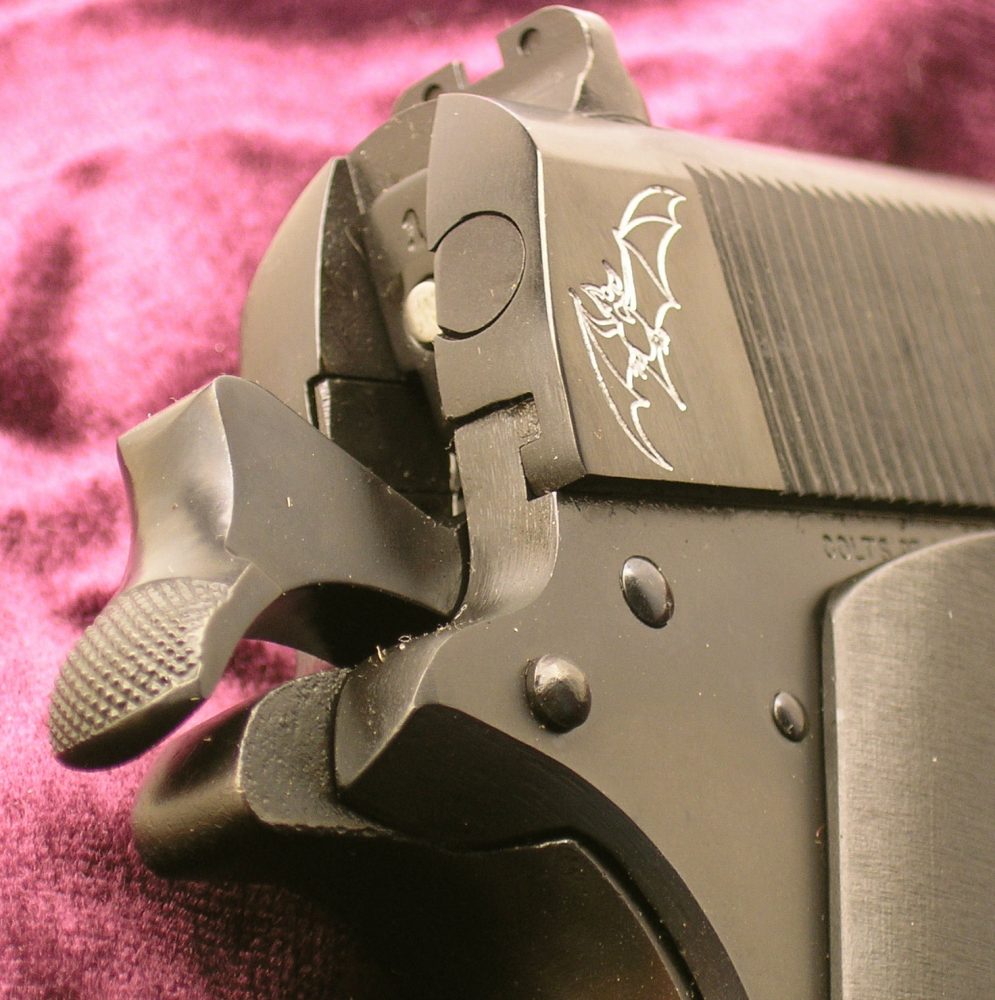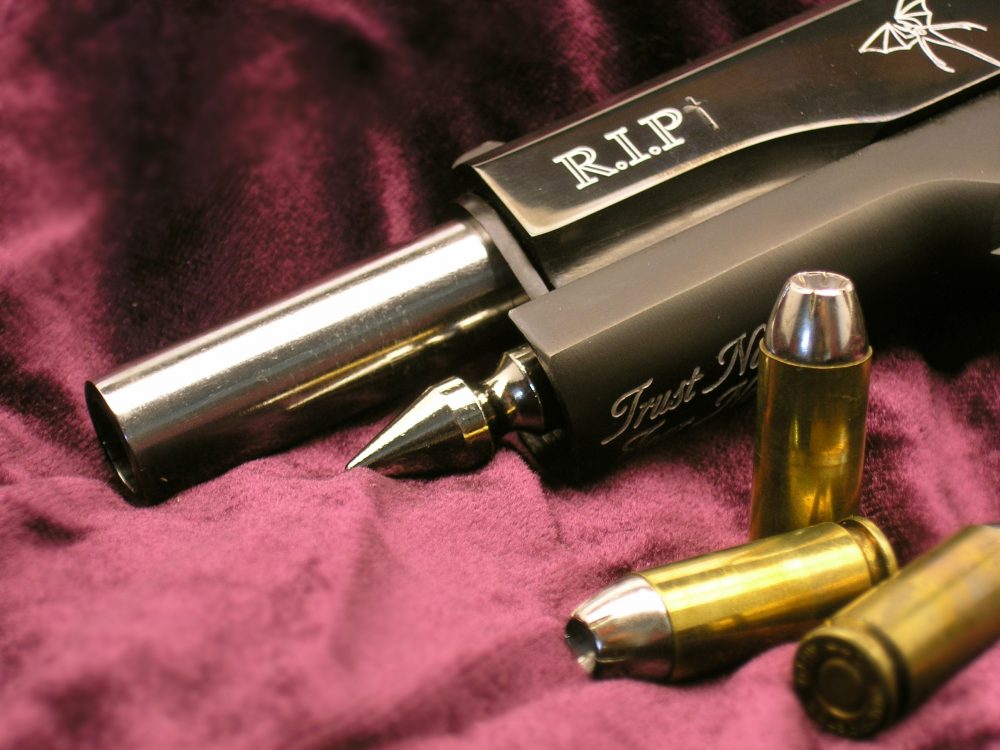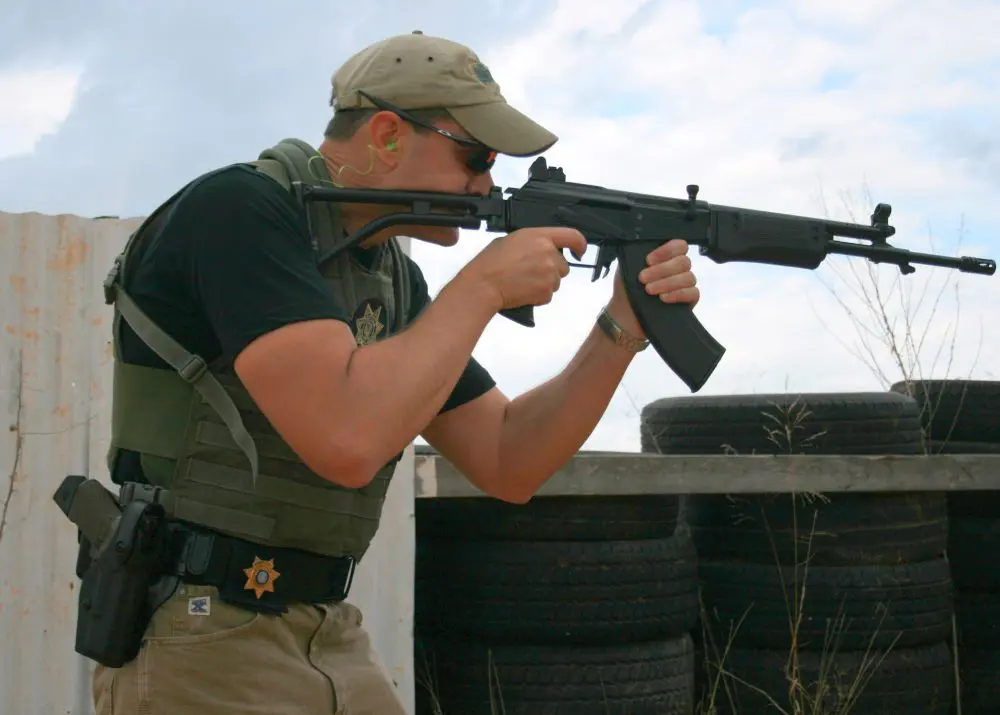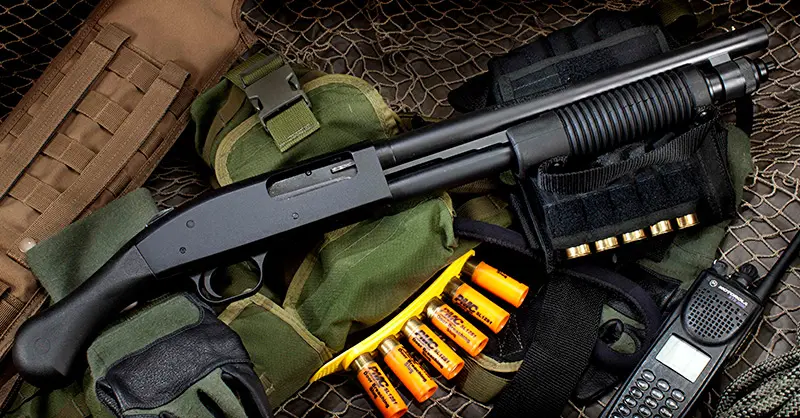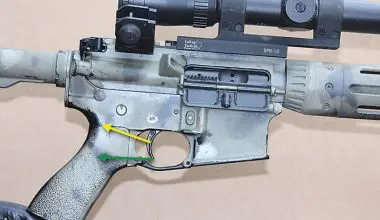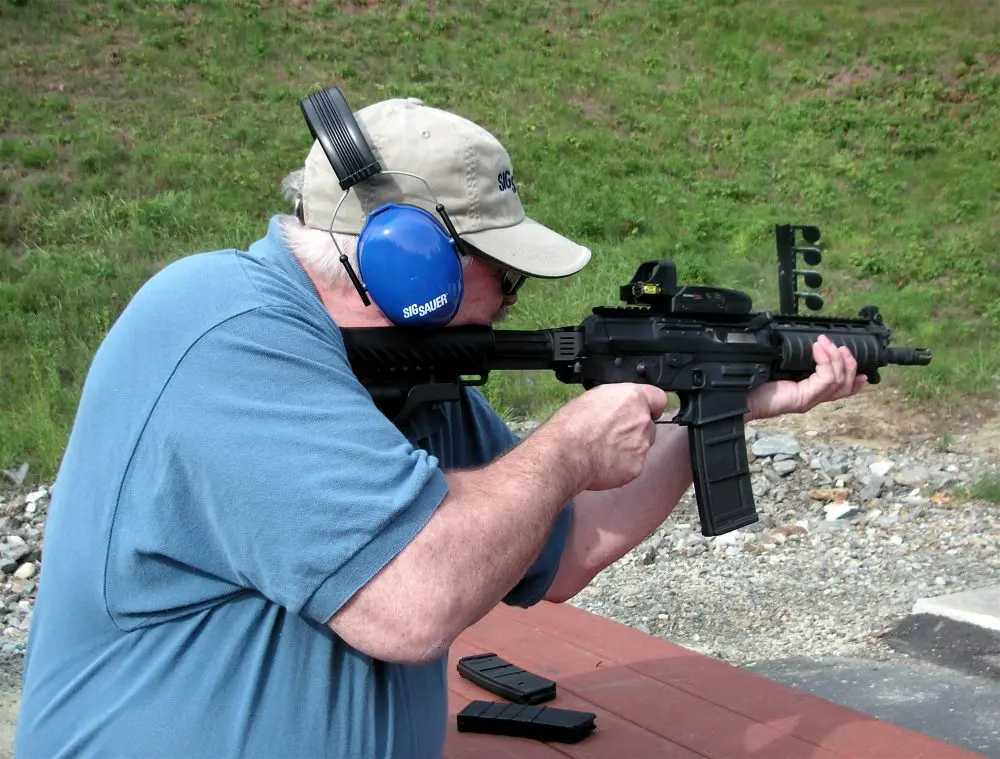Pistolsmith Kase Reeder spots a couple of zombies in the alley behind his workshop. Vampires tend to be nocturnal, but zombies can be hunted any time of the day or night.
Contrary to the official government line these days, blood-sucking vampires and brain-eating zombies are as lethal a threat to civilization as they’ve always been. Now there’s a new tool to help you deal with this dangerous situation.
The 10mm Vampyre Slayer, developed by pistolsmith Kase Reeder, is one of the greatest advances in the ongoing war against the undead since 1868 when President Ulysses S. Grant authorized the Federal Vampire and Zombie Agency (FVZA), modeled after the official vampire abatement programs of England and France. Before that, battles were fought with whatever private and government forces were available. In 1821, when a zombie plague overran Galveston Island off the coast of Texas in the Gulf of Mexico, the U.S. Navy responded by bombing every living thing on the island into oblivion.
The more surgical approach of the FVZA proved less wasteful. The agency got another boost in 1897, when President William McKinley transferred FVZA operations from a special branch of the Armed Forces to the Department of Justice, increasing its sweeping federal powers to root out and destroy vampires and zombies wherever they were found.
Care should be exercised when opening the Vampyre Slayer presentation case, as its coffin shape may attract any wandering baby vampires in the vicinity during naptime.
A very good year for pest control was 1911. The French developed a zombie vaccine that was claimed to be effective if administered soon enough. (A workable vampire vaccine would not be developed until 1950.) And Colt went into production of John Browning’s Model 1911 pistol, which was effective on both zombies and vampires no matter when it was administered, though shot placement proved to be a crucial factor. It’s widely known that the brain of the city-dwelling vampire is highly developed and therefore vulnerable, while the brain of the tropics-loving zombie is barely functional, but is sometimes capable of repairing itself. Rapid multiple hits with large bullets are thus a basic requirement, and the big-bore semiautomatic 1911 was the first handgun to provide this kind of firepower. The 1911 is the platform on which Kase Reeder wisely chose to build his Vampyre Slayer.
“The 1911 was the most widely used handgun among FVZA agents from the pistol’s inception,” Kase says. “It only required a few thoughtful improvements to make it better.”
The Russians once set off a nuclear bomb in a town square to kill a large pack of vampires. Americans use custom Colt 10mms instead.
Highly publicized FVZA extermination operations throughout the country culminated in 1935 in Key West, Florida when a once-a-century Category Five hurricane isolated the island and it was flooded by voracious zombies. Heavily armed FVZA assault teams were immediately called into action. It took them three weeks to secure the island and terminate more than 3,500 zombies—a significant portion of the population of Key West at the time.
Popular opinion being as fickle then as now, and whipped into a hypersensitive frenzy by the usual crowd of bleeding-heart vampire activists, public outcry resulted in a 1935 U.S. Supreme Court decision declaring that vampires have the same rights as human citizens. This ruling essentially stripped away the FVZA’s Powers of Termination, also known as the Right to Kill on Sight. Bureaucratic resilience won the day, however, as President Franklin Roosevelt quickly signed the Emergency Relief Act of 1936 which turned FVZA into a deep undercover operation, allowing agents and assault teams to carry on their work hidden from the prying eyes of the legal system and, for the first time, relieving the agency of the obligation to notify families of exterminated vampires and zombies.
Claims of victory in the 7,000-year war on vampires notwithstanding, it’s always wise to be prepared. That’s why President Ronald Reagan signed legislation in 1986 allowing government-supervised research on vampire blood.
Despite notable, though secret, success over the following decades, the FVZA continued to be the whipping boy of misguided social liberals and vampire sympathizers. In 1968, a Congressional Investigation Commission led by Wisconsin Democrat George Wheeler hammered the FVZA over its restrictive hiring policies, use of excessive force and civilian “collateral” casualties. The Wheeler Commission eventually came up with a series of burdensome new guidelines that deeply complicated the job of hunting vampires and zombies. The agency received less and less government funding and shrank in size until 1975, when President Gerald Ford disbanded the agency and Congress appropriated money to create the FVZA Museum to honor its past accomplishments. Not too long after the plug was pulled on the FVZA, Buffy the Vampire Slayer warned, “When the apocalypse comes … beep me.”
Rather than beeping Buffy, Kase Reeder decided to give her a little nudge from behind and take matters into his own hands. When I asked Kase, son of famous pistolmaker Gary Reeder, what possessed him to build such a specialized weapon, he said, “My father has been working on a spook gun for a certain gun editor for two years, a big-bore revolver, and he’s almost finished with it. I just didn’t think it wise to let a member of the press—you know how they are, and this one has unusually sharp teeth, by the way—walk around as the only properly armed man on the planet.”
The Vampyre Slayer is built on a 10mm Colt Delta Elite frame and slide, but in classic GI style including the original wide spur hammer, and with all the fine touches inside and out for which Kase Reeder is fast developing an enviable reputation among knowledgeable pistoleros.
You will notice that Kase’s Vampyre Slayer is a dual-purpose weapon, designed to stop heavily muscled zombies as well as thin-skinned vampires. “That’s the reason I decided to chamber the gun in 10mm,” Kase said. “I think the extra power is going to help. Even without silver bullets, this new stuff from Double Tap Ammunition should get the job done. My favorite load pushes a 135-grain JHP at 1,600 fps. I think that’s about right for making the undead dead again.”
The gun is also drop-dead gorgeous (no pun intended). It’s built on a Colt Delta Elite frame and slide, but in classic GI style including the original wide spur hammer, and with all the fine touches inside and out for which Kase Reeder is fast developing an enviable reputation among knowledgeable pistoleros. The gun is finished in black Chromex, a Reeder specialty, and is equipped with black anodized aluminum grips from AlumaGrips® because of their known resistance to bloodstains.
Doberman spikes come in handy for CQB.
“The spikes are for CQB,” Kase said. “They can be removed for more convenient concealed carry, but I recommend leaving them in place if you’re expecting trouble.” I could see the reasoning behind the fang-like spikes, a concept that follows the logic of German authorities who, in 1863, contracted with dog breeder Louis Doberman to create a breed of dog expressly for fighting vampires. With its unique blend of speed, ferocity and intelligence, the Doberman remains the gold standard in vampire control. But for those who live in small apartments and townhouses, and who are not afraid to get a little vampire blood on their hands, the tactically placed spikes on Kase’s gun should work quite well.
The highly customized Colt comes complete with engraved combat axioms like “Trust No One, Fear Nothing” to help engender the proper mindset, and iconic visual cues to remind you of the object of your mission.
Frankly, I’m not sure if I’ve ever seen a vampire or not, though there is a certain bar in Boise I’ve sometimes wondered about. I asked Kase, who is after all the designer of the modern Vampire Slayer’s weapon-of-choice, for advice on how to spot one of the creatures. He said, “I’m pretty sure if I ever saw one I would recognize it. And I think I would empty all four magazines into it.”
After capping the last round in the last magazine, when every vampire and zombie in sight was resting in peace, Buffy said, “We saved the world. I say we party.”
“So you think it would be better to shoot first and ask questions later?” I asked.
“That would be my recommendation,” he answered. “And, of course, head shots are always more reliable if you’re being charged, or if you find yourself surrounded by an aggressive pack.”
I didn’t want to offend Kase, but I was secretly thinking that President John Kennedy might have been right when, in a Rose Garden ceremony in 1963, he declared that the 7,000-year war on vampires had finally been won. So I asked Kase how he thought people might actually use this gun.“I think the gun speaks for itself,” he said. And he wouldn’t answer any more of my questions after that.
Surprisingly (or not), it turned out Kennedy was wrong. Long after his premature declaration of victory, vampire packs continued to turn up in isolated regions of the world. In 1967, the Siberian town of Lazo became infested with more than 750 rampaging vampires and Soviet authorities were forced to detonate a nuclear bomb in the town square to kill them all.
Kase is only going to make five of these Vampyre Slayer sets, so I shudder to think what fate may lay in wait for the rest of us. Each set includes the engraved gun with all of its expert gunsmithing work and integral accessories and four Chip McCormick magazines in a presentation case. Price is $2,295. That’s nothing when you consider that an official Federal Vampire and Zombie Agency kit dating from 1870 recently fetched $20,000 at a Sotheby’s auction. That kit contained a single-shot percussion pistol, blackpowder flask and lead balls, a logbook, pen and ink, and a large vial of powdered garlic. The name of the winning bidder has not been revealed.
Kase Reeder recommends Double Tap’s 135-grain JHPs at 1600 fps for vampires. For tougher-to-kill zombies, the author prefers Double Tap’s 180-grain Golden Sabers at 1330 fps or Texas Ammunition’s 200-grain flat points at 1250 fps or Cor-Bon’s 180-grain Bonded Core at 1320 fps. And you can always carry a spare magazine loaded with Winchester Silvertips just in case.
Sure, I know there are a lot of you out there who’ve become just a little lackadaisical in these carefree post-FVZA times and you don’t believe you need one of Kase Reeder’s fancy Vampyre Slayer pistols because, as you like to tell yourself, it can’t happen to me. Well, as a character on Buffy the Vampire Slayer once said, “It’s fuzzy-minded liberal thinking like that that gets you eaten.”
For those of you who think the author made up all this vampire and zombie stuff to help Kase Reeder sell guns, check out the website honoring the Federal Vampire and Zombie Agency (1868-1975) at www.fvza.org or contact the Santa Rosa Institute of Advanced Genetic Research in Albuquerque, New Mexico, www.srigenetics.com. Memorable quotes from the TV series Buffy the Vampire Slayer can be found at www.starpulse.com/Television/Buffy_The_Vampire_Slayer/Quotes/.
For the five of you who are serious about protecting yourself and your family from blood-sucking vampires and brain-eating zombies, you can only get the special custom-designed 10mm Vampyre Slayer 1911 from Kase Reeder.
[Robert H. Boatman is the author of Paladin Press books about the 1911, Glocks and big-bore rifles, has a Doberman named Spike, and can be reached at [email protected].]
SOURCES:
Reeder Custom Guns
Dept. S.W.A.T.
2601 E. 7th Avenue
Flagstaff, AZ 86004
(928) 527-4100
www.reedercustomguns.com
Hot-loaded 10mm ammo is available from:
Cor Bon
Dept. S.W.A.T.
1311 Industry Road
Sturgis, SD 57785
(605) 347-4544
www.corbon.com
Double Tap Ammunition
Dept. S.W.A.T.
4956 West 6200 South, #512
Salt Lake City, UT 84118
(866) 357-10MM
www.doubletapammo.com
Texas Ammunition Company
Dept. S.W.A.T.
P.O. Box 248
Ballinger, TX 76821
www.texas-ammo.com
ALUMAGRIPS
Dept. S.W.A.T.
2851 North 34th Place
Mesa, Arizona 85213
(602) 294-2390
www.alumagrips.com


